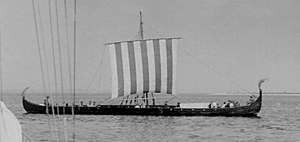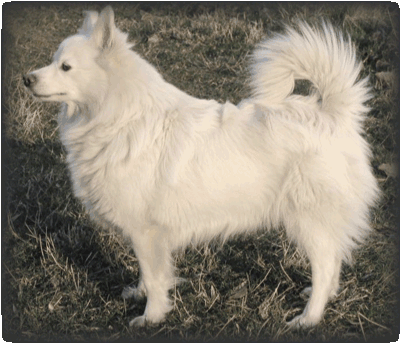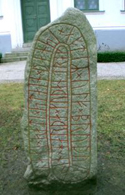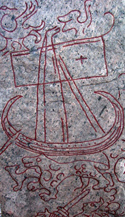While dogs were first domesticated from wolves (below) at least 15,000 year ago, it was not until about three thousand years ago that dogs began to migrate from the Arctic into the more temperate climates of Europe, North America, Asia, and to a lesser extent, Africa. Dogs who came to inhabit different regions began to take on similar yet distinctive appearances.
Based on the age of skeletal remains unearthed in Switzerland, several types of dogs can be traced back to the Viking Age, the period between 793 and 1066 AD in Scandinavia and Britain, when Scandinavian (mostly Dane and Norwegian) raiders, conquerors, and colonists raided and explored most parts of Europe, south-western Asia, northern Africa and north-eastern North America. These venturesome Scandinavians became known as the Vikings. Those from Norway favored Scotland, Ireland, and England as their destination. Danish Vikings looted towns in England, Germany, the Netherlands and France. The Swedes traveled eastward into northwestern Russia.
The Vikings in the west often did no more than take the treasure already accumulated in towns and monasteries. Booty included, gold, silver and gems. On the other hand, the Scandinavians who ventured into European Russia found nomads in the lush prairie lands of southern Russia and hunter-gatherers, most of them Finno-Ugrians, in the northern forest zones. Here in Russia the Vikings found a wealth of furs that could be traded for central Asian silverware and coins.
Scholars who of studied archaeological remains from the Viking Age believe that many, if not most, Viking Age Scandinavians did not go out raiding. Instead, they lived in the countryside where they farmed, raised cattle, hunted and fished. Survival was a continual struggle for the Vikings. Much of their land was among rough woods and mountains where winters were long and brutally cold. Short summers did not provide a long growing season for food crops. The Vikings employed methods of iron extraction and rock quarrying to make cooking utensils and whetstones, for sharpening blades and tools. Every member of a farm family shared in the work. The men, worked in the fields, hunted and fished. Women cooked and preserved the food, spun and wove wool, and sewed clothes. Because husbands and sons might be away from home for months or even years at a time, either fishing or making trading or raiding voyages, the women ran the farms in their absence. The youngest children probably contributed by helping to feed the anminals or gathering firewood.
The harsh living conditions for most Vikings may have been what led many Vikings to take to the sea, venturing throughout Europe. The Vikings' ship building skill was first discovered in 1880 when archeologists uncovered a large burial mound that contained the remains of what today is called a longship (below) built between 850 and 900 AD. Since that discovery, modern boatbuilders have reconstructed old Viking ships, and sailors have used them to retrace some of the likely Viking journeys. Much of the Vikings' successes as raiders, traders, and settlers may have been due to their well made ships.

Designed for speed, the longship was a long, narrow, light-weight wooden boat with a shallow draft (meaning the ship was not immersed deeply in the water). These ships could travel on rivers no more than three feet deep. The shape of the longships was symmetrical, allowing the ship to reverse direction quickly. The Vikings were among the first to use a keel, or a narrow strip of wood down the center of the ship's underside, to add to its stability. Some of the Viking ships had a single rectangular sail, but the ships were also rowed with oars positioned along almost their entire length. Since there were no benches inside the boat, presumably the oarsmen sat on their sea chests to row. The hulls of their ships were built of overlapping planks of oak tied to the ribs of the ships with animal hair or roots of spruce trees. Stuffing the joints with rope, yarn or tar made the ships watertight. It is believed that Viking sailors navigated by observing the stars and the flights of birds.
The Vikings also build trading ships, known as knarrs, for carrying cargo and settlers to new lands. At about 53 feet long, they were shorter than longships, with deeper drafts that would have been useful for shipping supplies, people and animals across the seas. |
 |
Skeletal remains around 2,000 years old unearthed in Switzerland indicate that spitz-type dogs (above) have inhabited Central Europe for millennia. With their characteristic thick fur, pointed ears and muzzle and tail that curled over the dog's back, the European spitz-type dogs were almost certainly the ancestors of today's Karelian Bear Dogs, based on the similarities in physical characteristics and temperament.
Evidence of dogs during the Viking Age has been found in Viking Age art and writing. The alphabet used by the Vikings consisted of 16 letters that were angular in shape, which made them easy to carve into stone or metal. This runic alphabet was used to write Germanic languages before and shortly after the Christianization of Scandinavia and the British Isles. Our earliest surviving runic inscriptions date to the second century AD. (Latin literacy eventually replaced this system of writing.)  Left, standing slabs of stone (usually limestone) that were inscribed with Viking language are known as rune stones. Those stones that presented their message in pictures rather than runes are sometimes referred to as image stones. Left, standing slabs of stone (usually limestone) that were inscribed with Viking language are known as rune stones. Those stones that presented their message in pictures rather than runes are sometimes referred to as image stones.
Rune stones were used more broadly, more enthusiastically, and by more people in Scandinavia during the Viking Age than in any other time or place. There are approximately 6,000 known rune stones in Scandinavia. Runic inscriptions offer insight into the development of language and poetry, kinship and habits of name-giving, settlement, place-names and  communications, and Viking as well as trading expeditions. Right, Viking Age art inscribed on rune stones depicts many dogs. communications, and Viking as well as trading expeditions. Right, Viking Age art inscribed on rune stones depicts many dogs.
The great popularity of dogs as working animals and as companions is also evidenced by the frequency with which they are found in graves, buried alongside their masters. Many warriors' graves that date back to Viking Age burials contained the bones of one or more dogs, and it is speculated that dogs were included in burials to accompany their master to the afterlife, guiding them to the underworld. Viking Age graves in Denmark, Brittany, the Isle of Man, and elsewhere containing the remains of dogs show that the custom of sending a person's dogs with them to the afterlife was widespread throughout the Viking World.
Many of the dogs kept by the Vikings were hunting dogs, bred to assist in the chase. Several varieties of spitz-type hunting dogs dating back to the Viking Age survive to the present day. Through selective breeding, spitz types evolved to fit three purposes helping humans: hunting, herding, and pulling sleds. The Karelian Bear Dog, one of the spitz-type dogs, is believed to have been used primarily for hunting small fur-bearing animals (such as squirrels and marten). Like the Norwegian Elkhound, the Karelian Bear Dog was also used in hunting moose, lynx, wolf and, as its name suggests, the Eurasian brown bear (a bear species as large and aggressive as the American Grizzly). |
|